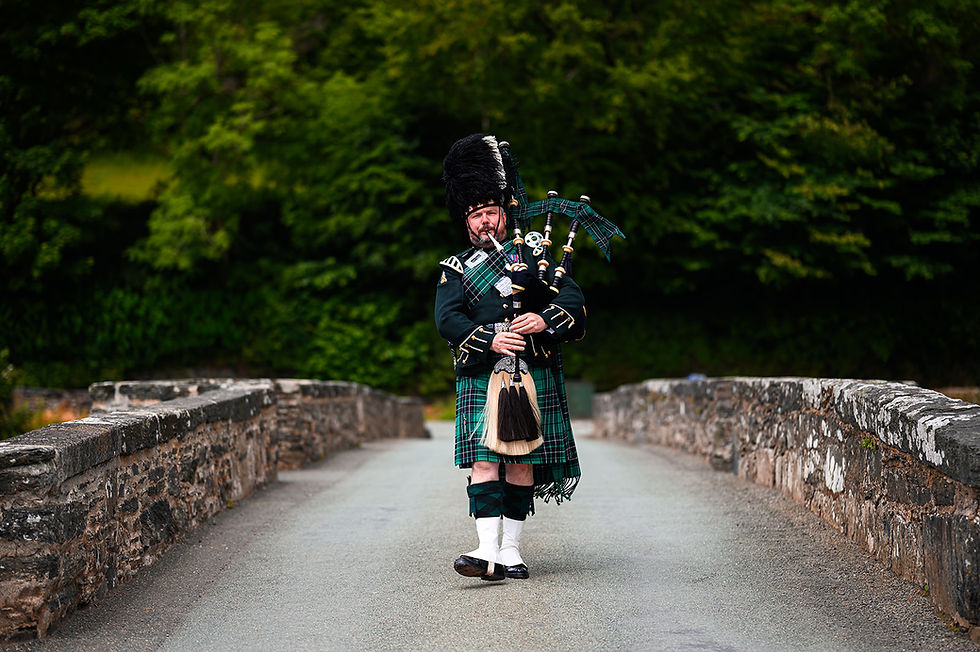The Rich History of the Bagpiper
- pipemajorpaton
- Sep 13
- 4 min read
Bagpipes have been emblematic of Scotland (and Ireland) for a long time, evoking visions of breathtaking landscapes, vibrant festivals, and the unique tunes that resonate in the air. The history of bagpipers in Scotland is as diverse and rich as the landscapes they inhabit. From ancient times to today, bagpipers have played a pivotal role in shaping Scottish culture and tradition.
In this blog post, we will delve into the fascinating history of bagpipers in Scotland, explore the various roles they fulfil, and examine the organizations and events that depend on their distinctive talents.
A Brief History of Bagpiping in Scotland
The origins of bagpiping in Scotland trace back to ancient times, with evidence of the instrument's use as early as the 14th century. The Great Highland Bagpipe, the most renowned type, is believed to have developed from earlier instruments introduced by Celtic tribes.
Music has always played a significant role in Scottish life. Clan Chiefs would hire harpists to perform the clan's music, which recounted past deeds, people, and events in the clan's history. Over time, the highland piper replaced the harpist, taking their place in the clan chief's court as the guardian of the clan's history.
Following the Jacobite defeat at Culloden in 1746, the government sought to prevent any future uprisings. The Highland clans' support for restoring the Stuart line to the British throne was a significant aspect of the Jacobite uprising. Consequently, many elements of highland identity were prohibited, including the bagpipes.
One way to circumvent the ban was by joining a Highland regiment, where wearing tartan and, importantly, playing the bagpipe were permitted. No longer able to perform for their clans, pipers found a new, equally vital role in their regiments. As in their court position, they became the keepers of regimental history. Wherever the highland regiment traveled, they were led by their pipers. Every milestone, battle, and farewell to a fallen comrade was marked by the pipers. Sometimes tunes were composed to commemorate an event or person, while other times a simple haunting melody marked the end of the day. In every instance, the bagpipe was integral to the daily life of the highland soldier.
Over the years, highland regiments journeyed across the globe, with each visit marked by the pipers. The world became acquainted with and enamored by the highland bagpipe. As a result, among all the bagpipes worldwide, the Great Highland Bagpipe is the most famous and recognized.
Where the bagpipes are heard
Bagpipers are frequently engaged to play at weddings, funerals, and public events, either individually or as part of a group. Their music contributes emotional depth and a distinctive ambiance, often leaving attendees with lasting memories.
1. Weddings and celebrations.
Bagpipes have traditionally been used to accompany dancing. Initially, clan warriors would perform dances over their swords and shields to attract good fortune for upcoming battles. Energetic, lively tunes challenged both the dancers and the piper. As clans transitioned to more peaceful times and battles ceased to dominate highland life, the dances evolved into ceremonial events, with new styles emerging. Once more, pipers played music for the dancers. Today you will see these traditions being upheld at the highland games where dancers perform the highland fling to the sound of the bagpipe.
2. Funerals and memorials.
Due to their strong ties to the martial traditions of clans and the military responsibilities of the highland regiments, pipers have long been tasked with leading the way for their fallen clan members and fellow soldiers. Highland funerals or memorials are distinguished by the haunting sounds of a lone piper playing an emotional lament. For the clans and regiments, this lament was a familiar tune, rich with meaning for those mourning a loss. Although clans and regiments no longer hold as significant a place in society as they once did, pipers are still often called upon to play these airs and laments, honoring our history, respecting our loved ones, and connecting us to our ancestors.

Do Bagpipers still have a role today?
While employment opportunities with local Lairds or Clan Chiefs have decreased, pipers remain in high demand. Nowadays, pipers are more accessible, and you don't need to be a clan leader or royalty to hire one for your event. Pipers are sought after for funerals, weddings, formal gatherings, and even birthday parties, not only in Scotland but worldwide.

The Cultural Significance of Bagpiping
Bagpiping is not just music; it is an essential element of Scotland's cultural identity. The sound of bagpipes evokes pride and nostalgia, linking individuals to their heritage.
Recently, there has been a growing interest in traditional music, with bagpiping at the forefront. This resurgence inspires the creation of new compositions and collaborations across different genres, preserving the art form while honoring its historical connections.
The Enduring Impact of Bagpipers on Scottish Culture
The journey of bagpipers in Scotland serves as a powerful reminder of music's ability to forge connections and celebrate tradition. From their ancient origins to their contemporary roles, bagpipers have significantly shaped Scotland's cultural landscape.
Whether they are bringing warmth to weddings, competing in vibrant festivals, or mentoring the next generation of musicians, bagpipers continue to inspire and unite people through their artistry. As we honour this rich heritage, we recognise the diverse contributions of bagpipers in our communities and their enduring impact on Scottish culture.
However, it's not just Scottish culture that has been influenced. Over the years, the highland bagpipe has reached every corner of the globe. Thriving piping communities exist throughout the UK, as well as in North America, Europe, Asia, Africa, and Oceania, each blending the bagpipe with their own cultural identities.


Comments